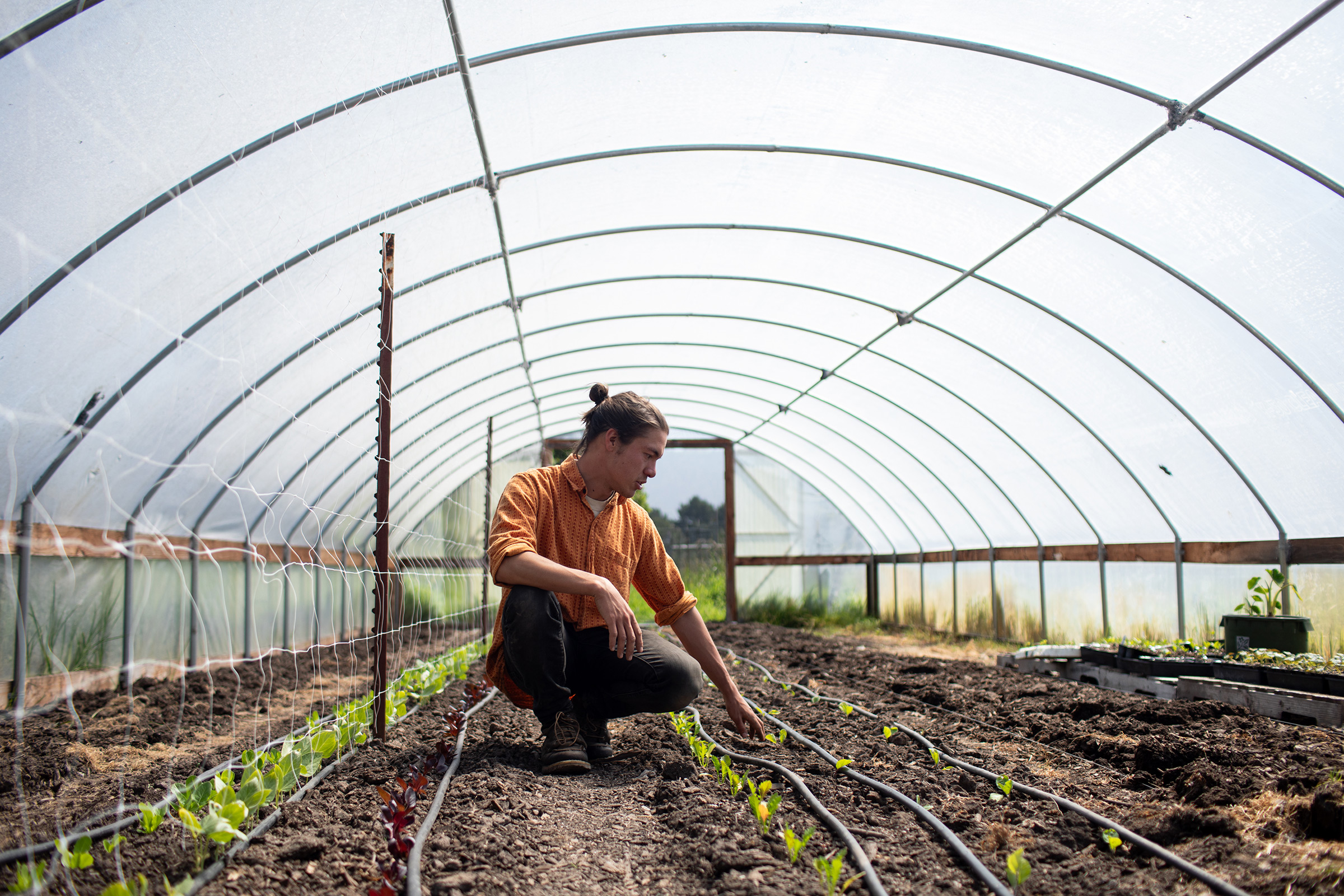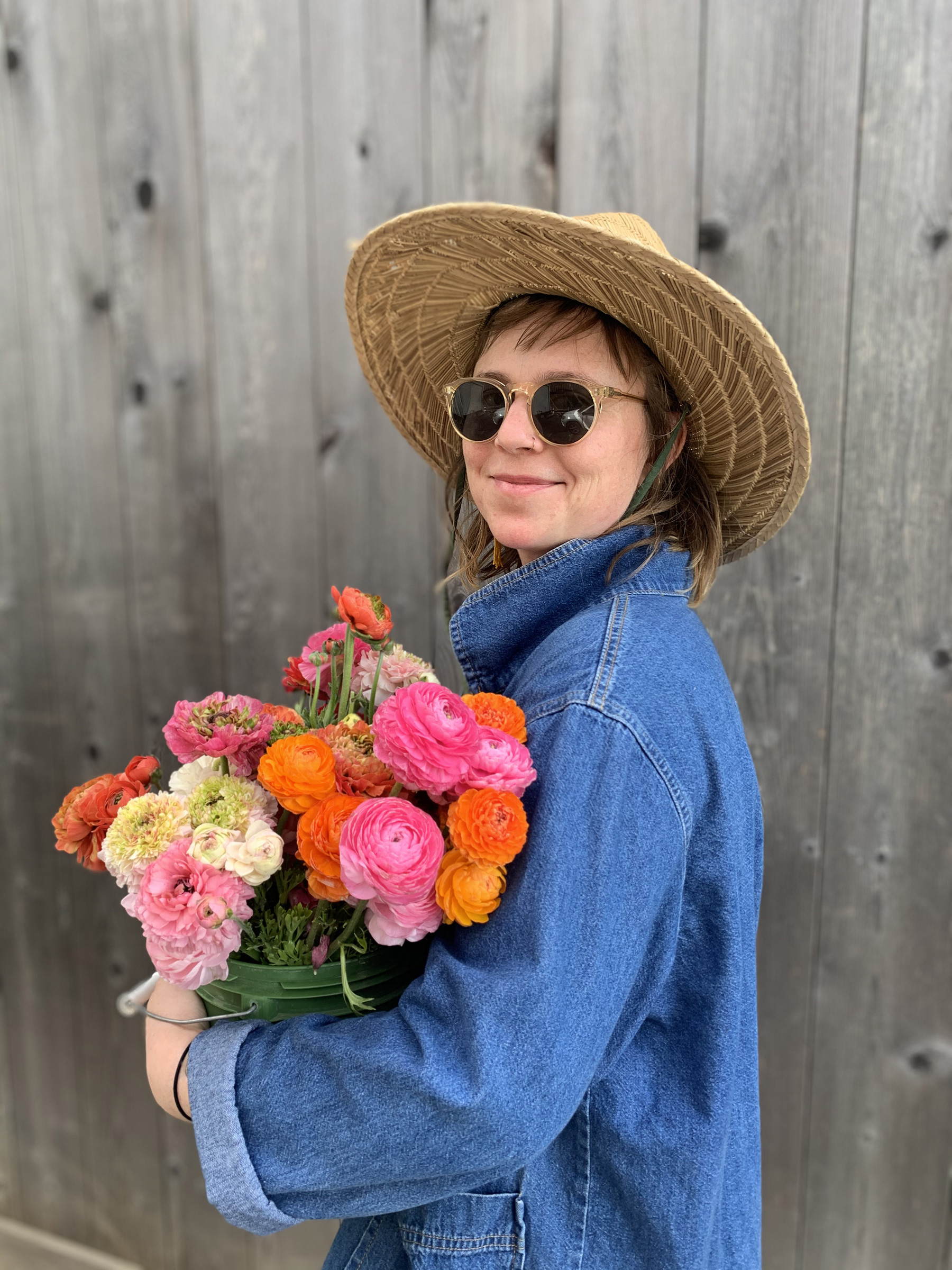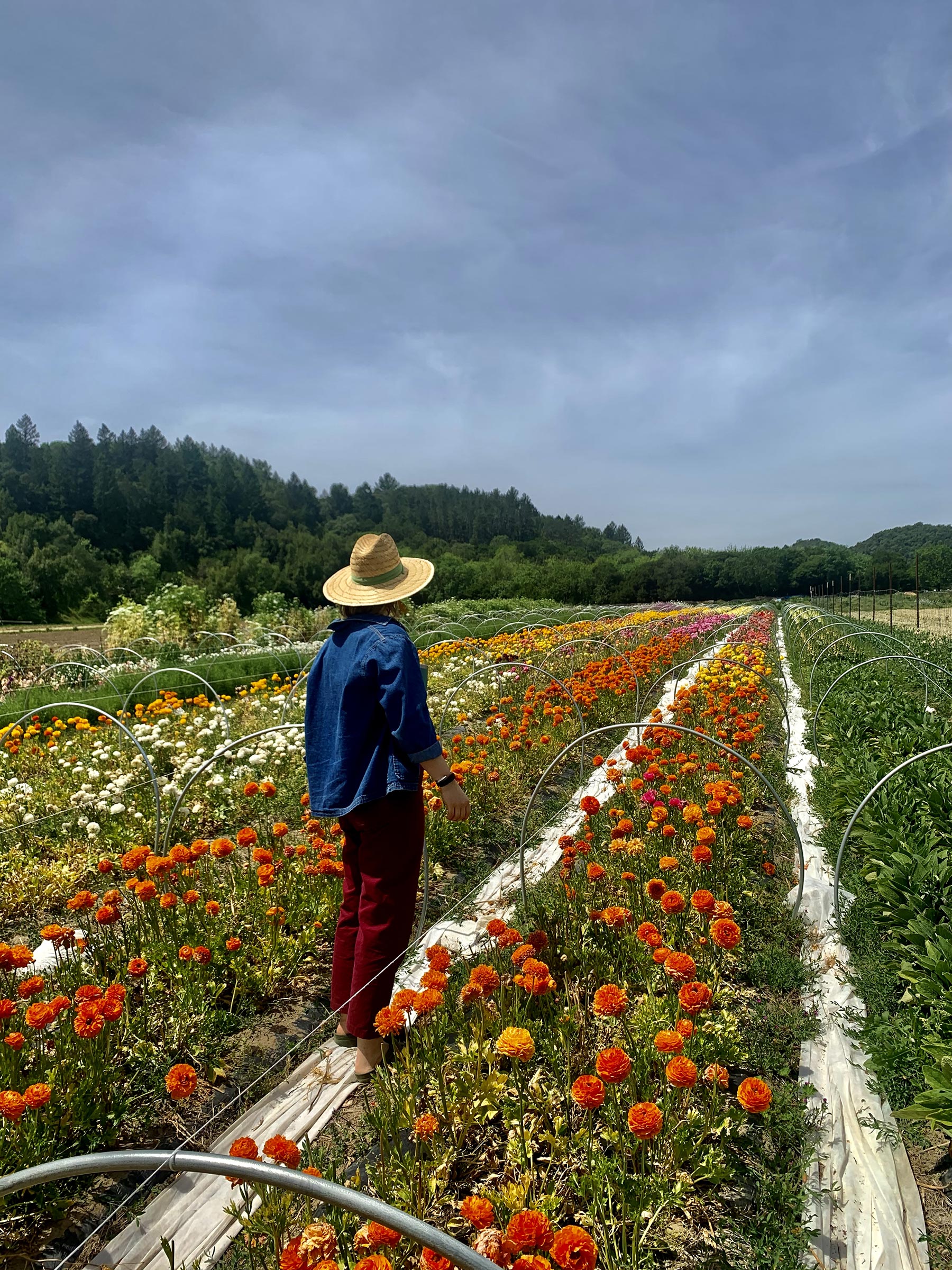In 2023, Scott Chang-Fleeman—a young farmer like me—put down his shovel. A post on his Instagram read, “Shao Shan Farm, in its current form, is going on indefinite hiatus.” From the outside, the burgeoning farm had the makeup of one that could stand the test of time. In reality, his experience of farm ownership was wrought with challenges.
A farmer in his late 20s, Chang-Fleeman started Shao Shan Farm in 2019 to reconnect with his roots and provide a source of locally grown heritage Asian vegetables to the Bay Area. He quickly secured a clientele and fan base—two of the greatest hurdles of starting a farm—and became the go-to for San Francisco’s high-end Asian eateries.
But after four years of creative pivots to withstand unexpected hurdles that included financial stress, severe drought, and a global pandemic, Chang-Fleeman made a choice that many young farmers are considering: to leave farming behind. Why he left and what could have kept him on the land are critical questions we must address if we are to have a sustainable and food-secure future.
The USDA Census of Agriculture reported that in 2017, nearly 1 in 4 of the 3.4 million agricultural producers in the US were new and beginning farmers. Many of these new farmers are doing exactly what it seems American agriculture needs: starting small farms. According to the most recent data from the Agricultural Resource Management Survey (ARMS) in 2019, farms with annual sales of less than $100,000 accounted for about 85% of all U.S. farms. And though not all of these small-scale farms are necessarily organic, small farms are more likely to grow a diversity of crop types, use methods that reduce negative impacts on the climate, increase carbon sequestration, and tend to be more resilient in the face of climate change.
Read More: How Extreme Weather Is Affecting Small Farmers Across the U.S.
There has been a growing interest among younger people in recent years in sustainable and organic farming practices, as well as in local food systems. This interest has led people in their 20s and 30s to enter into small-scale farming, particularly in niche markets such as organic produce, specialty crops, and direct-to-consumer sales.
As a result, both congressional Democrats and Republicans have maintained that encouraging young people to farm is of utmost importance in ensuring the stability of our food system. But getting young people into farming may not be the problem. Keeping them on the farm may be the hardest part.
I should know. I quit too.

Chang-Fleeman got his start in agriculture right out of college, where he spent several years working at the on-campus farm. As a third-generation Chinese American, he noticed a distinct lack of Asian vegetables at local farmers markets, particularly those that were grown organically, and suspected there would be a demand should a supply exist. He started trialing some varieties, and his suspicions were quickly affirmed when samples of his choy sum caught the attention of chef Brandon Jew of Mister Jiu’s, a contemporary Chinese eatery with a Michelin star in the heart of San Francisco’s Chinatown. Jew provided some seed funds for what was to become Shao Shan Farm in 2019.
During the first year running his farm, Chang-Fleeman focused his sales on his relationships with local restaurants, while attending some farmers' markets sales to supplement income. But when the COVID-19 pandemic hit in early 2020, he lost all of his restaurant accounts overnight.
Like many farmers at that time, he pivoted to a CSA model, offering farm boxes that provide a household with an assortment of vegetables for the week.
“So literally over a night, I reworked my crop plan” he told me. “Just to get through that year, or through that season, not knowing how long [the pandemic was going to] last.”
As if a global pandemic wasn’t enough, in 2021, California entered a drought, and he lost the ability to irrigate his crops come mid-summer, which meant a hard stop for production.
“I was hoping to hit some sort of a rhythm, and every year felt a bit like starting from scratch,” Chang-Fleeman reflected.
Throughout farm ownership, he worked side jobs to compensate for the slow build of business income and the fact that he could only afford to pay himself a monthly salary of $2,000. He regularly worked 90 hours a week. At the same time, farm expenses were on the rise.
“The cost of our packaging went up like three times in one year and the cost of the produce didn't change,” he explained. “Our operating expenses went up like 30%, after COVID.”
In four short years, Chang-Fleeman experienced an avalanche of extenuating circumstances that would bring most farm businesses to their knees. But the thing that finally catalyzed the closing of his business was burnout. He relayed the experience of the exhaustion and stress building over time until he reached a breaking point. “If I don’t stop now, it’s going to kill me,” he recalled thinking.
Chang-Fleeman’s burnout reminded me of my own story. In the fall of 2018, I took what ended up being a two-month medical leave from an organic farm I managed in Northern California in order to try to try to resolve a set of weird symptoms that included dizzy spells and heart palpitations. If you know anything about farming, fall is not the time to be absent. It’s peak harvest time and the culmination of all of your work is underway. But as my medical anomaly continued to worsen, I came no closer to getting back to work. After many doctor visits, several trips to the specialist, a flurry of blood tests, and a week of heart monitoring, it took one Xanax to solve the mystery.
Read More: ‘They’re Trying to Wipe Us Off the Map.’ Small American Farmers Are Nearing Extinction
The prolonged physical stress that I had been harboring at work had triggered the onset of panic disorder, a nervous system affliction that had led me into a near-chronic state of fight or flight mode, causing a swath of physical symptoms not typically associated with “anxiety.”
For me, this was a wake-up call. I turned to a slew of Western and naturopathic remedies to alleviate my symptoms, but ultimately, removing the stressors of farm management was the thing that allowed me to, mostly, reach a nervous system balance. Even still, six years later, I’m constantly navigating the ‘new normal’ of this diagnosis.
A pilot study conducted by agriculture researcher Josie Rudolphi and her colleagues in 2020 found that of 170 participants, approximately 71% met the criteria for Generalized Anxiety Disorder. By comparison, in the US, an estimated 18% of adults experience an anxiety disorder. Rudolphi’s work indicates that these disorders maybe three times more prevalent in young farmer and rancher populations.
This rang true as I went from farm to farm trying to figure out what so often goes wrong in a new farm operation. Again and again mental health was a through-line. Collette Walsh, owner of a cut-flower operation in Braddock, PA, put it to me bluntly: "I usually get to a point in late August or early September, where there’s a week where I just cry.”
How can we build a farming economy that helps young farmers not only stay, but also thrive on the land? The Farm Bill, a federal package of legislation that provides funding for agricultural programs, is one route. As the reboot of the Farm Bill approaches, it’s a critical time to ask these questions and advocate for policies that support young farmers and the barriers they’re facing in maintaining a long-lasting career in agriculture.
Take for instance, Jac Wypler, Farmer Mental Health Director at the National Young Farmer Coalition (Young Farmers), who oversees the Northeast region’s Farmer and Rancher Stress Assistance Network (FRSAN). The organization was established by the Farm Bill in 2018 to develop a service provider network for farmers, ranchers, and other agricultural workers that was dedicated to mental well-being. Through the network of service providers she directs, called “Cultivemos,” Wypler and her colleagues utilize a multi-tiered approach to address mental health in farming spaces. Cultivemos partners provide direct support in moments of stress and crisis as well as peer-to-peer support spaces.
An expanded (and subsidized) program that scales efforts like Cultivemos to a size commensurate with the young work force is clearly needed. But it’s only part of the picture.
“While we believe that it is important to make sure that farms, farmers, and farmworkers are getting direct support around their mental health,” Wypler explained. “We need to alleviate what is causing them stress.”
Cultivemos works to address the structural root causes of stress which can include climate change, land prices, and systemic racism, to name a few. They focus on communities that are disproportionately harmed by these structural root causes, specifically Black, Indigenous, and other farmers of color. Finally, they seek to make this impact by regranting funding directly into the hands of these farmers.
“The way I think of regranting is that the USDA and these large institutions are the Mississippi River of funding.” Wypler says. “We’re trying to get the funding into these smaller rivers and tributaries to disperse these funds and shift that power dynamic and leadership dynamic.”
The next Farm Bill cycle will be critical in ensuring this work is continued. In November of 2023, lawmakers signed a stopgap funding bill that allows for a one-year extension on the 2018 Farm Bill. Lawmakers are currently in deliberations over the bill until September when it will be up for a vote. Young Farmers underscores the importance of the appropriations process, which is when program areas that are authorized in the farm bill are allocated funding.

Back-to-the-landism has waxed and waned throughout the last hundred years, booming in the pre-Depression years of the 1930s, dying in the war years and then storming back in the 60s and 70s. When my generation’s own farming revolution came along in the early 2000s, I was similarly swept up. I imagined when I chose to farm that the path would be lifelong. What I hadn’t accounted for, as a determined, starry-eyed changemaker, was the toll that a decade of farming through wildfires, evacuations, floods, power outages, and a global pandemic would take on my mental health.
Don’t get me wrong: I was happy working hard with my two feet planted firmly on the land. In a better world I and people like Scott Chang-Fleeman would have kept getting our hands dirty, making an honest, if modest, living providing good and wholesome food in synch with the rhythms of the planet.
But to borrow a word from the world of ecology, being a young farmer in today’s economy is “unsustainable.” The numbers don’t work economically and, eventually, any mind trying to square this un-squarable circle is going to break. The economic, physical and mental challenges are all interconnected.
It’s hard to find an American, Republican or Democrat, red or blue state resident that doesn’t want more young hands on the land. We all rightly see agriculture as a pathway to personal fulfillment and a way to make our food supply healthier and more secure. But words and intentions can only do so much. We must answer these very real problems with very real subsidy.
If we don’t, my generation might be the last to think of going “back-to-the-land” as something actually worth doing.
More Must-Reads from TIME
- Introducing the 2024 TIME100 Next
- The Reinvention of J.D. Vance
- How to Survive Election Season Without Losing Your Mind
- Welcome to the Golden Age of Scams
- Did the Pandemic Break Our Brains?
- The Many Lives of Jack Antonoff
- 33 True Crime Documentaries That Shaped the Genre
- Why Gut Health Issues Are More Common in Women
Contact us at letters@time.com
